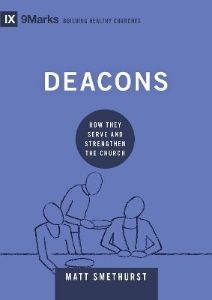Book Review: Deacons – How they serve and strengthen the Church
<- Back
Deacons – How they serve and strengthen the Church
Book Author: Matt Smethurst
Review Author: Wayne Pleiter
Byford Free Reformed Church
Pro Ecclesia Bookshop
Deacons – How they serve and strengthen the Church, by Matt Smethurst
2021/176pages
Last October, some 100 men came together for the Seek Wisdom Deacon’s conference. It was a
wonderful evening reflecting on the task of the deacons as they work within the congregations. The
evening’s discussions indicated a strong desire from the deacons to do more, yet they did not feel
equipped or empowered to do so. In the end, the conference was a call and encouragement for
deacons to be proactive in their task, seeking ways to serve and strengthen the Church.
The conference program included a comprehensive book list to assist deacons in their task. One of
the books on this list was: ‘Deacons – How they serve and strengthen the Church’, by Matt
Smethurst. The summary provided in the conference program read as follows:
“Deacons are essential to church health - yet there is no clear consensus about their biblical job description. In this book, Matt Smethurst makes the case that they are model servants called to meet tangible needs, organise, and mobilise service, preserve the unity of the flock, support the ministry of the elders, and further the mission of the church.
Relying on Scripture to clear the confusion, Smethurst details - in an engaging and practical way - how deacons can be deployed as healthy models of service to help congregations flourish. Simple to read and very practical.”
I would have no hesitation to agree with this basic summary, and yet more can be said. The book is
engaging to read and provides many practical applications for the deacons to consider. In the
commendation to the book, Dr Van Dam affirms that this book ‘is not a dry, theoretical treatise but a
clear and cogent call to recognise God’s irreplaceable gift of the diaconal ministry.’ What makes this
book readable and enjoyable is the many personable illustrations that capture the practical aspects
of the deaconry.
This book is relatively short with six chapters and two appendices (totalling 155 pages). The first
chapter briefly outlines the various ways deacons have functioned throughout church history – from
the Middle Ages to the Reformation, to the churches of today. The second chapter deals with the
New Testament origins of deacons and summarises four key learnings from Acts 6. These include 1)
the priority of the ‘Word Ministry’, 2) congregation involvement in selecting deacons, 3) the
necessary attributes of a deacon, and 4) the division of labour amongst the office-bearers.
The third chapter expands further on the deacon’s attributes and character requirements. The
author highlights that the biblical qualifications for elders and deacons are essentially the same, with
only one attribute unique to the elders (and you will need to read it to find out what it is…). The
fourth chapter moves from what a deacon must be to what a deacon must do. This chapter provides
a careful consideration of how deacons and elders ought to work together.
The fifth chapter provides some real-life stories giving examples of what has worked in different
church situations (from inner city churches to rural church plants). For most, the stories will be
foreign to our Reformed context but do provide food for thought. The final chapter highlights the
beautiful aspect of deacons reflecting the love and mercy of our Saviour in their service!
Of the two appendixes, the first addresses the question of whether women may serve as deacons.
While Smethurst, briefly outlines the two opposing arguments of the issue, he does more to affirm
the position that supports his preference. The final appendix provides sample questions for
prospective deacons to consider should they desire the office. The questions are simple but pointed
and helpful for personal reflection.
Overall, I enjoyed reading this book. As mentioned, Smethurst uses vivid examples and writes
accessible to many audiences. However, there was something I was unsettled about. And perhaps a
lot has to do with the context of this book. Let me explain. The author, Matt Smethurst is part of the
Baptist tradition, having served both as a deacon and elder in his local church. If you are a regular
reader of the Gospel Coalition, you may have seen the name Matt Smethurst before, as he serves as
an editor and regular contributor.
Within the context of the Baptist tradition, it is not uncommon for churches to only have deacons
serving in the churches – no elders! In so many ways, the deacons in Baptist churches function with
authority and leadership equivalent to the role of elders. Often this is done to the neglect of the ministry
of mercy. This book desires to correct this imbalance. As Smethurst states, ‘We rob ourselves of the
benefits of God’s revealed wisdom when we either unduly elevate the role of deacons (say, to de
facto elders) or unduly reduce their role (say, to glorified janitors).’ (Page 21-22, emphasis in
original.)
Clearly, this context is very different from our situation in our Reformed Churches. The contrast
becomes greater when the author advocates specific organised roles and ministries within the local
churches. What we call Committee of Management, Ushers, Women Auxiliary Committees, Audio
Visual Committees, Music Committees – all are the types of ministries the author advises to help
support, engage, and unite the congregation. The author posits that the more the deacons can take
care of these practical matters, the more the elders and pastors can focus on their role of teaching
and shepherding the flock.
Once I understood the context and background of the book, I could see how it would be helpful
within the FRCA context. In so many ways, the FRCA has all the ‘systems in place’ for which the
author advocates, and we could easily dismiss this book by saying we have got this all covered.
Nothing to see here! But that would be a mistake, as Smethurst is not advocating for
the implementation of new systems – but rather the author gives practical suggestions so that deacons
can better serve with joy and heartfelt commitment for the strengthening of the church. His
suggestions are intended to foster heartfelt and deliberate service. The author is passionate about
the diaconate and desires to activate the deacons into faithful service, so that the ministry of the
Gospel might be maintained.
It is interesting that this was the same desire for the Active Deacons Conference. While we might
have these ‘systems’ in place, the question is whether they are working. Have we done such a good
job of organising and formalising the work that we have lost the heart for the work? Do we really
love and care for those in our wards? Are we committed to active and heartfelt service? And in so
many ways, this is precisely what the book hopes to encourage.
Understanding the context is critical to getting the most out of this book. If you are a newly
ordained deacon and want a good book that is concise and practical, then this is the book for you.
For the experienced deacon, this book is a good reminder to be proactive and deliberate in your
service, discovering new ways to love and care for those in your ward. For the regular member in the
pew, this book highlights the wonderful gift that deacons are, as they serve and strengthen the
church. As Smethurst affirms; ‘When deacons flourish, the whole congregation wins.’ (Page 22).

